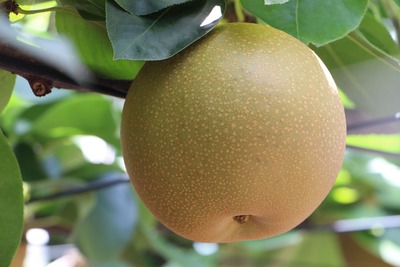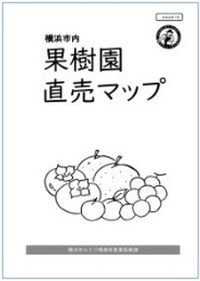- Yokohama-shi Top Page
- Municipal Government Information
- Public Relations, Public Information, News
- Public Relations and Publications
- Public Relations Printed Materials
- Public information Yokohama
- Public information Yokohama-shi version
- Discover Yokohama Aya
- August 2024 issue "None beach" raised in Yokohama
Here's the text.
August 2024 issue "None beach" raised in Yokohama
Yokohama with sea, port, greenery, history, region, people and various attractions. We will deliver the color of this city as "Yokohama Aya Discovery". This time, it is just about the seasonal Yokohama specialty product "Hamanashi".
Last Updated September 2, 2024
As for the publication contents of "public information Yokohama" August, 2024 issue "Yokohama Aya discovery", please see link.
"No beach" grown in Yokohama
What is no beach?

No beach
The pear brand name produced in Yokohama, not the pear variety name, but the pear that meets some conditions is certified as "Hama no Nashi". Yokohama agricultural cooperative registered trademark in 2015. In 1985, it was selected as one of the "100 Best Kanagawa Products" and is still one of the 74 Kanagawa brands (as of May 2024).
"Hama-nashi" is harvested at the most ripe timing, with the eyes of farmers, keeping the trees at the very end. The beach is fresh and needs to be handled delicately, rarely shipped to the market. As a result, they are rarely seen in retail stores such as supermarkets.
Hamanashi is sold directly at the farmhouse's garden. Some farmers set up a red "Nobori" with the word "no beach" to inform them that they are on sale.
The secret of the taste without a beach is not just to harvest ripen. Appropriately give fertilizer using organic materials according to the timing of growth, and appropriate the number of flowers and fruits, and the number of branches so that plenty of nutrients can be reached to the fruit, without a large and fine beach I take care of pear trees every day to grow up.
History without a beach

Pear flower
Pears in Yokohama were cultivated in the Tsurumi River basin in the early Taisho era. In a time when there were still many floods, pears seemed to have been chosen because they were relatively resistant to floods. Later, when the Pacific War began, orchards were turned into potato fields due to food shortages, and pear gardens almost disappeared.
In the 1980s, pear cultivation resumed in Kuroganecho, Kohoku Ward (now Aoba Ward), Shinyoshida-cho, Kohoku-ku, and Shimo-Iida-cho, Totsuka Ward (now Izumi Ward). From 1941 to 1943, a tourism orchard project was implemented mainly in the Nakazato area (Midori Ward and Aoba Ward), in which consumers were able to take advantage of their close location. From 1946 to 1955, a fruit park setting project was implemented with the aim of fostering urban agriculture and securing recreational green spaces for citizens. About 20 ha of pear gardens of "Kosui" and "Hosui" were created. Furthermore, in the tourism and agriculture promotion project that began in 1981, pear gardening has spread to the whole city.
Initially, "Hamanashi" was not well-known, and in addition to installing signboards and advertising newspaper flyers, some farmers ran mini SLs in pear gardens and publicized them. The notation "Hamanashi" was also various, "Hamanashi" and "Hamanashi", but it seems in the latter half of the Showa 50s that the notation was unified as "Hamanashi" as it gradually increased its name recognition and promoted branding .
Cultivation of pears

Pear pollen
In addition to the harvest season, pears are cultivated throughout the year. In the spring, work begins with "brushing / flower picking", "pollen collection", and "artificial pollination". Since pears are not pollinated by pollen between the same varieties, they are given different varieties of pollen. Since pollination can only be performed during a limited time before and after full bloom, it is a very busy time for pear farmers.
From late April to May, the work of picking fruit begins. In the pollination stage, more fruits can be formed, so by picking unnecessary fruits and reducing them to the appropriate number of fruits, the nutrients are concentrated on the fruits to be harvested and growing large and sweet fruits.
In June, we manage branches called "Shin". The main purpose is to prepare for flower buds next year and to secure sunshine. In addition, we cut grass, perform additional fruit picking work, and depending on the farmer, we pack each fruit.
Fruit picking workshop
From late July to early August, harvesting of early varieties begins. Some farms sell "Akemizu (outside site)" and "Korei (outside site)" grown by Kanagawa Prefecture. The mainstream variety "Kosui" is harvested before and after the tray. Even in the same Yokohama city, the harvest time is different, and early and late districts may differ for about 10 days.
Harvesting of Hosui, a mainstream variety similar to Kosui, begins about 10 days after Kosui. Until about 20 years ago, "Hosui" was sold before and after Respect for the Elderly, but now it is sold from late August to early September.
Cultivation of pears continues to be difficult due to global warming. The flowering time is about one week to 10 days earlier, the fruit grows without rain during the time when the fruit grows, and the plum blossoms are actually damaged by locally falling hail, and the product value of pears is lost in some years.
Recently, a disability fruit called "foot disease", in which a part of the pulp becomes translucent and becomes softer, has occurred. There is no problem with eating "mitsu" itself, but farmers stop selling at stores as soon as they find it because the taste and texture deteriorate. Initially, the pears of "mitsu" had to be discarded, but in recent years, they have been reborn as new products, such as collecting and purchasing them at JA Yokohama and using them as materials for sweets and alcoholic beverages. Was.
Overcoming various difficulties, it is lined up in the garden of a beach Shiga farmer cultivated with great care. Please enjoy it this summer.
Confectionery (Dorayaki) using beachless ingredients [limited time]
Alcoholic beverages made from beach-free [limited time]
Sale date and location
The beach-free sales season is usually from mid-August to early September, but in 2024, due to the weather, the sales season may be earlier than usual. The sales place is below or on the city site "How to buy no beach, beach grapes, and fruits grown in Yokohama?" Please refer to the following page.
- Holding fair
- Shared direct sales outlets
Nakayama Ekimae Pear Direct Sales Office (North Exit of JR Nakayama Station, in front of Miyoshi Seed Building)
Kitahatsusaku Agricultural Products Direct Sales Office (Kitahatsusaku-cho, Midori-ku)
- Individual direct sales outlets (in the city)Orchard direct sales mapYou can download it in PDF format.
[Reception end] Reader present
The application has been closed and prizes have been sent to the winners on Monday, September 2nd. Thank you very much for your application.
Thank you for always seeing "Public Information Yokohama" and "Yokohama Aya Discovery". We will present a "Yokohama Farm" eco bag to 5 people by lottery from those who have received their impressions. If you wish, please refer to the following six items. ※Please specify and apply by postcard (to Yokohama City Hall Policy and Management Bureau, 6-50-10 Honcho, Naka-ku, Yokohama 231-0005) or e-mail (sss-saihakken@city.yokohama.jp). The deadline must arrive on Sunday, September 1, 2024.
※ 1.Postal code, 2. Address, 3. Name, 4. Impression, 5. I would like to read, 6. "I wish to present the August issue"
The winner's announcement will be returned by sending the prize. In addition, the personal information you receive will not be used for any purpose other than sending prizes.
Public Relations Section, Policy Management Bureau, Yokohama City Hall TEL: 045‐671-2331 FAX: 045‐661-2351
Inquiries to this page
Green Environment Bureau Agriculture Promotion Section
Telephone: 045-671-2637
Telephone: 045-671-2637
Fax: 045-664-4425
Page ID: 972-934-610








